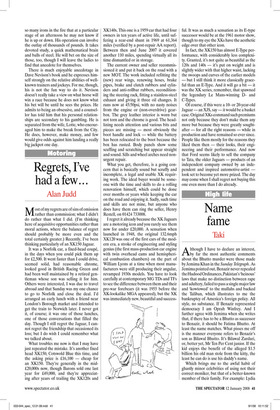Regrets, I’ve had a few...
Alan Judd
Most of my regrets are of sins of omission rather than commission; what I didn’t do rather than what I did. (I’m thinking here of acquisitive opportunities rather than moral actions, where the balance of regret should probably be more even and the total certainly greater.) Recently, I’ve been thinking particularly of an XK150 Jaguar.
It was a Norfolk car, a fixed-head coupé, in the days when you could pick them up for £2,500. It went faster than I could drive, seemed solid, had reasonable chrome, looked good in British Racing Green and had been well maintained by a retired gentleman whose son was selling it for him. Others were interested, I was due to travel abroad and that Sunday was my one chance to go to Norfolk and close the deal. I’d arranged an early lunch with a friend near London’s Borough market and intended to get the train to Norwich later. I never got it, of course; it was one of those lunches, one of those conversations that filled the day. Though I still regret the Jaguar, I cannot regret the friendship that occasioned its loss; but I do wish I could remember what we talked about.
What troubles me now is that I may have just repeated the mistake. It’s another fixed head XK150, Cotswold Blue this time, and the asking price is £16,100 — cheap for an XK150. They’re generally in the mid£20,000s now, though Barons sold one last year for £49,000, and they’re appreciating after years of trailing the XK120s and XK140s. This one is a 1959 car that had four owners in ten years of active life, until suffering a rear-end shunt in 1969 at 61,364 miles (verified by a post-repair AA report). Between then and June 2007 it covered another 110 miles, spending virtually all its time dismantled or in storage.
The current owner and seller recommissioned it and put it back on the road with a new MOT. The work included refitting the (new) rear wings, renewing hoses, brake pipes, brake and clutch rubbers and cylinders and anti-rollbar rubbers, reconditioning the steering rack, fitting a stainless-steel exhaust and giving it three oil changes. It runs now at 45/50psi, with no nasty noises from the engine or (non-overdrive) gearbox. The grey leather interior is worn but not torn and the chrome is good. The headlining needs attention and various bits and pieces are missing — most obviously the boot handle and lock — while the battery has been relocated to the boot because the box has rusted. Body panels show some scuffing and scratching but appear straight and sound. Sills and wheel arches need nonurgent repair.
What you get, therefore, is a going concern that is basically sound but scruffy and incomplete, a legal and usable XK requiring work. The ideal buyer would be someone with the time and skills to do a rolling renovation himself, which could be done over months or years while keeping the car on the road and enjoying it. Sadly, such time and skills are not mine, but anyone who does have them can ring the seller, Henry Restell, on 01424 733008.
I regret it already because the XK Jaguars are a motoring icon and you rarely see them now for under £20,000. A sensation when launched in 1948, the original 132.6mph XK120 was one of the first cars of the modern era, a stroke of engineering and styling genius (the first mass-production car engine with twin overhead cams and hemispherical combustion chambers) on the part of William Lyons at a time when most manufacturers were still producing their angular, revamped 1930s models. You have to look carefully at contemporary MG TDs and TFs to see the difference between them and their pre-war forebears (it was 1955 before the XK-lookalike MGA appeared), but the XK was immediately new, beautiful and success ful. It was as much a sensation as its E-type successor would be at the 1961 motor show, though to my eye the XKs have the aesthetic edge over that other icon.
In fact, the XK150 has almost E-Type performance, with considerably less complexity. Granted, it’s not quite as beautiful as the 120s and 140s — it’s put on weight and is slightly wider with that higher waist, lacking the swoops and curves of the earlier models — but I still think it more classically graceful than an E-Type. And it will go a bit — it was the XK series, remember, that spawned the legendary Le Mans-winning Dand C-Types.
Of course, if this were a 10or 20-year-old Jaguar — an XJS, say — it would be a basket case. Original XKs command such premiums not only because they don’t make them any more but because they were greatly soughtafter — for all the right reasons — while in production and have remained so ever since. People like them mostly for the reasons they liked them then — their looks, their engineering and their performance. And now that Ford seems likely to sell the company to Tata, the older Jaguars — products of an independent company owned by an independent and inspired automotive-artist — look set to become yet more prized. The day may come when I shall regret not buying this one even more than I do already.


























































 Previous page
Previous page